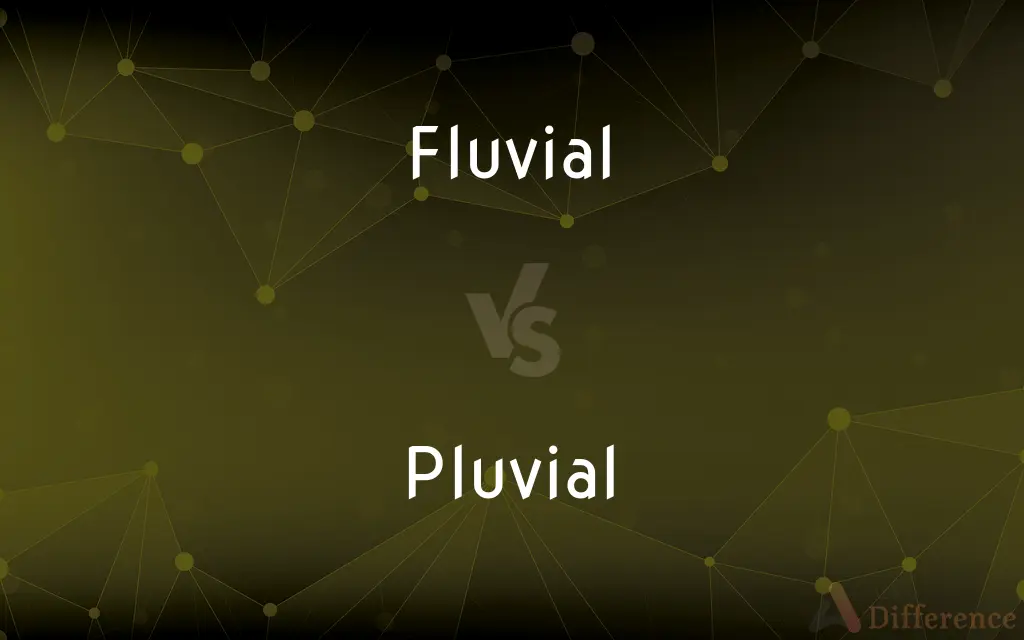Fluvial vs. Pluvial — What's the Difference?
By Tayyaba Rehman & Maham Liaqat — Updated on April 2, 2024
Fluvial pertains to rivers and stream processes, influencing landscapes and ecosystems. Pluvial relates to rain and its impact on the environment and hydrology.

Difference Between Fluvial and Pluvial
Table of Contents
ADVERTISEMENT
Key Differences
Fluvial processes are associated with rivers and streams, focusing on the movement, deposition, and erosion of sediments that shape river landscapes and influence ecosystems. Pluvial, on the other hand, refers to rainfall and its related phenomena, including the impact of rainwater on the landscape, such as erosion, runoff, and the replenishment of lakes and groundwater.
While fluvial processes are continuous and influenced by various factors including river flow, sediment supply, and topography, pluvial effects are more episodic, depending on precipitation patterns, storm frequency, and intensity. Both fluvial and pluvial phenomena are integral to hydrology and environmental planning, affecting water resource management, flood risk assessment, and the design of urban infrastructure to mitigate adverse effects on human settlements and natural landscapes.
The interplay between fluvial and pluvial processes is evident in the hydrological cycle, where rainfall (pluvial) contributes to river flow (fluvial), demonstrating the interconnectedness of these natural processes. Understanding both fluvial and pluvial dynamics is essential for sustainable environmental management, particularly in the context of climate change, which is altering precipitation patterns and river flows worldwide.
Despite their distinct focus, fluvial and pluvial processes overlap in their contribution to shaping the Earth's surface and influencing water cycles, demonstrating the complex relationship between water in motion and water from precipitation in the natural world.
Comparison Chart
Definition
Relating to rivers and streams.
Relating to rain and its effects.
ADVERTISEMENT
Key Processes
Erosion, deposition, transportation.
Rainfall, runoff, infiltration.
Influences on
River landscapes, deltas, floodplains.
Urban flooding, groundwater recharge.
Frequency
Continuous, depending on river dynamics.
Episodic, based on precipitation events.
Management Concerns
Flood risk, sediment transport, ecosystem health.
Stormwater management, urban planning, flood mitigation.
Compare with Definitions
Fluvial
Integral to water resource management.
Understanding fluvial dynamics is essential for flood prevention.
Pluvial
Can cause urban flooding.
The city implemented green infrastructure to mitigate pluvial flooding.
Fluvial
Pertaining to the actions of rivers and streams.
Fluvial processes shaped the canyon over millennia.
Pluvial
Related to rain and its impact on the environment.
Pluvial floods occur when heavy rainfall overwhelms drainage systems.
Fluvial
Affects landscape through erosion and deposition.
The fluvial landscape includes features like meanders and oxbow lakes.
Pluvial
Influences water cycles and hydrology.
Pluvial conditions affect groundwater recharge rates.
Fluvial
Involves water flow in natural channels.
Fluvial sedimentation contributes to delta formation.
Pluvial
Requires effective stormwater management.
Pluvial water management strategies include rain gardens and permeable pavements.
Fluvial
Supports ecosystems with nutrient distribution.
Fluvial environments are vital for aquatic biodiversity.
Pluvial
Affects soil erosion and runoff.
Pluvial erosion can lead to significant soil loss in agricultural areas.
Fluvial
Of or found in a river
Fluvial processes
Fluvial deposits
Pluvial
In geology and climatology, a pluvial is either a modern climate characterized by relatively high precipitation, or an interval of time of variable length – decades to thousands of years – during which a climate is characterized by either relatively high precipitation or humidity. Subdivisions of a pluvial, which are characterized by relatively high precipitation, are known as a subpluvials.
Fluvial
Of, relating to, or inhabiting a river or stream.
Pluvial
Of or relating to rain; rainy.
Fluvial
Produced by the action of a river or stream.
Pluvial
Marked or formed by abundant rainfall
Pluvial periods.
A pluvial lake.
Fluvial
Of, pertaining to, inhabiting, or produced by the action of a river or stream.
Pluvial
An extended period of abundant rainfall, especially such a period of the Pleistocene Epoch.
Fluvial
Belonging to rivers; growing or living in streams or ponds; as, a fluvial plant.
Pluvial
Of, pertaining to, or produced by rain
Fluvial
Of or relating to or happening in a river;
Fluvial deposits
Pluvial
(geology) occurring through the action of rain
Pluvial
(geology) a rainy period
Pluvial
Of or pertaining to rain; rainy.
Pluvial
Produced by the action of rain.
Pluvial
A priest's cope.
Pluvial
Marked by rain;
Their vacation turned out to be a series of rainy days
Common Curiosities
What is fluvial geomorphology?
Fluvial geomorphology studies how rivers and streams shape the Earth's surface, focusing on processes like erosion, sediment transport, and deposition.
How do pluvial floods differ from fluvial floods?
Pluvial floods result from heavy rainfall causing runoff that exceeds drainage capacity, while fluvial floods are caused by rivers overflowing their banks.
What role do fluvial processes play in ecosystem health?
Fluvial processes transport nutrients and sediments, creating diverse habitats and supporting aquatic and riparian ecosystems.
Why are fluvial landscapes important for agriculture?
Fluvial landscapes, such as floodplains, are fertile due to sediment deposition, making them valuable for agriculture.
What measures can mitigate the impact of pluvial flooding?
Measures include creating permeable surfaces, enhancing drainage systems, and implementing green infrastructure like rain gardens and swales.
What is the significance of studying fluvial sediments?
Studying fluvial sediments helps in understanding past environmental conditions, river dynamics, and guiding river management practices.
How does climate change impact fluvial and pluvial processes?
Climate change can alter precipitation patterns and river flows, affecting fluvial erosion, deposition, and pluvial flood frequencies.
What is a pluvial lake?
A pluvial lake is a body of water formed by rainfall accumulation during periods of increased precipitation, often in arid regions.
What challenges do fluvial systems face from human activity?
Challenges include pollution, dam construction, water extraction, and land use changes, affecting river health and biodiversity.
Can pluvial events affect river systems?
Yes, heavy rainfall (pluvial) increases runoff into rivers, potentially leading to increased river flow (fluvial) and even flooding.
How is urban planning affected by pluvial concerns?
Urban planning must consider pluvial flooding by incorporating green infrastructure, improving drainage, and managing stormwater to prevent flooding and waterlogging.
How is water quality affected by fluvial and pluvial processes?
Water quality can be influenced by pollutants carried by runoff (pluvial) and river flow (fluvial), necessitating effective management practices to protect water resources.
How do fluvial processes contribute to delta formation?
Fluvial processes transport sediments to river mouths, where they deposit and form deltas, extending land into bodies of water.
How can communities prepare for pluvial and fluvial flood risks?
Communities can prepare by implementing flood defenses, improving urban infrastructure, and planning for emergency response to flooding events.
Can pluvial flooding be predicted?
Pluvial flooding can be predicted to some extent through weather forecasting and monitoring urban drainage capacities.
Share Your Discovery

Previous Comparison
Explanation vs. Analysis
Next Comparison
Beauceron vs. RottweilerAuthor Spotlight
Written by
Tayyaba RehmanTayyaba Rehman is a distinguished writer, currently serving as a primary contributor to askdifference.com. As a researcher in semantics and etymology, Tayyaba's passion for the complexity of languages and their distinctions has found a perfect home on the platform. Tayyaba delves into the intricacies of language, distinguishing between commonly confused words and phrases, thereby providing clarity for readers worldwide.
Co-written by
Maham Liaqat















































